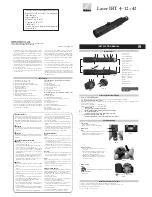
`
9
CELESTIAL OBSERVING
With your telescope set up, you are ready to use it for observing. This section covers visual observing hints for solar system and deep sky objects as well as general
observing conditions which will affect your ability to observe.
O
O
b
b
s
s
e
e
r
r
v
v
i
i
n
n
g
g
t
t
h
h
e
e
M
M
o
o
o
o
n
n
Often, it is tempting to look at the Moon when it is full. At this time, the face we see is fully illuminated and its
light can be overpowering. In addition, little or no contrast can be seen during this phase.
One of the best times to observe the Moon is during its partial phases (around the time of first or third quarter).
Long shadows reveal a great amount of detail on the lunar surface. At low power you will be able to see most of
the lunar disk at one time. Change to optional eyepieces for higher power (magnification) to focus in on a smaller
area.
Lunar Observing Hints
To increase contrast and bring out detail on the lunar surface, use optional filters. A yellow filter works well at
improving contrast while a neutral density or polarizing filter will reduce overall surface brightness and glare.
O
O
b
b
s
s
e
e
r
r
v
v
i
i
n
n
g
g
t
t
h
h
e
e
P
P
l
l
a
a
n
n
e
e
t
t
s
s
Other fascinating targets include the five naked eye planets. You can see Venus go through its lunar-like phases. Mars can
reveal a host of surface detail and one, if not both, of its polar caps. You will be able to see the cloud belts of Jupiter and
the great Red Spot (if it is visible at the time you are observing). In addition, you will also be able to see the moons of
Jupiter as they orbit the giant planet. Saturn, with its beautiful rings, is easily visible at moderate power.
Planetary Observing Hints
•
Remember that atmospheric conditions are usually the limiting factor on how much planetary detail will be visible.
So, avoid observing the planets when they are low on the horizon or when they are directly over a source of radiating
heat, such as a rooftop or chimney. See the "Seeing Conditions" section later in this section.
•
To increase contrast and bring out detail on the planetary surface, try using Celestron eyepiece filters.
O
O
b
b
s
s
e
e
r
r
v
v
i
i
n
n
g
g
t
t
h
h
e
e
S
S
u
u
n
n
Although overlooked by many amateur astronomers, solar observation is both rewarding and fun. However, because the Sun is so bright, special precautions must be
taken when observing our star so as not to damage your eyes or your telescope.
For safe solar viewing, use a proper solar filter that reduces the intensity of the Sun's light, making it safe to view. With a filter you can see sunspots as they move
across the solar disk and faculae, which are bright patches seen near the Sun's edge.
•
The best time to observe the Sun is in the early morning or late afternoon when the air is cooler.
•
To center the Sun without looking into the eyepiece, watch the shadow of the telescope tube until it forms a circular shadow.
O
O
b
b
s
s
e
e
r
r
v
v
i
i
n
n
g
g
D
D
e
e
e
e
p
p
-
-
S
S
k
k
y
y
O
O
b
b
j
j
e
e
c
c
t
t
s
s
Deep-sky objects are simply those objects outside the boundaries of our solar system. They include star clusters, planetary nebulae, diffuse nebulae, double stars and
other galaxies outside our own Milky Way. Most deep-sky objects have a large angular size. Therefore, low-to-moderate power is all you need to see them. Visually,
they are too faint to reveal any of the color seen in long exposure photographs. Instead, they appear black and white. And, because of their low surface brightness, they
should be observed from a dark-sky location. Light pollution around large urban areas washes out most nebulae making them difficult, if not impossible, to observe.
Light Pollution Reduction filters help reduce the background sky brightness, thus increasing contrast.
Star Hopping
One convenient way to find deep-sky objects is by star hopping. Star hopping is done by using bright stars to "guide" you to an object. For successful star hopping, it
is helpful to know the field of view of you telescope. If you’re using the standard 25 mm eyepiece with the PowerSeeker telescope, your field of view is approximately
0.7º or so. If you know an object is 3º away from your present location, then you just need to move about four fields of view. If you’re using another eyepiece, then
consult the section on determining field of view. Listed below are directions for locating two popular objects.
The Andromeda Galaxy (Figure 5-1), also known as M31, is an easy target. To find M31:
1.
Locate the constellation of Pegasus, a large square visible in the fall (in the eastern sky, moving toward the point overhead) and winter months (overhead, moving
toward the west).
2.
Start at the star in the northeast corner—Alpha (
α
) Andromedae.
3.
Move northeast approximately 7°. There you will find two stars of equal brightness—Delta (
δ
) and Pi (
π
) Andromeda—about 3° apart.
4.
Continue in the same direction another 8°. There you will find two stars—Beta (
β
) and Mu (
μ
) Andromedae—also about 3° apart.
5.
Move 3° northwest—the same distance between the two stars—to the Andromeda galaxy.
























